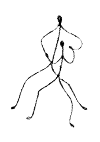 |
ROUND DANCING — CHOREOGRAPHED BALLROOMEDUCATIONAL ARTICLESMAJOR SECTIONS: Figures | Articles | Links | Alph. Index | Search | Home |
|
|
Teaching Bolero Stylingby Annette Woodruff I teach the technique at the same time as the steps, because without it the steps are … nothing but a mechanical displacement of feet. Styling is something else — to do with how you are using your arms, your head … and I don't "teach" it. My students probably imitate what I do. You cannot, however, teach a rhythm without teaching the technique simultaneously, unless you want all the rhythms to look like each other. I start with figures that they already know — the first one being the New Yorker. In Rumba, the slow step is the side step. They have no trouble understanding that if we change the timing to SQQ, they'll need to start with the slow step = the side step. We do a few SQQ New Yorkers without any particular styling. Then I explain the three levels of Bolero — the low, the very high, and the very low. We start low and dance the three steps of New Yorker as very high, -, very low, low. The 3 levels are all in the body, not in the feet. The very high is achieved not only with a full straightening of the knees but also an extension of the body up — reflected in the hips, the chest, the neck. The very low is achieved as a "drop" with maximum bending of the knees. The "low" is a normalizing of the position with the knees still soft (softer than they would be in Two Step, similar to a Tango low). After practicing this, I introduce the last important point: the recover is not in place. I have them stop after the first two steps of the New Yorker and look at the foot on which they'll recover, then I have them push on their supporting foot to move their recovering foot a little further away before transferring weight to it. After we have practiced that and looked at everybody individually, I am done. I have taught Bolero. They only know New Yorkers, but once they know this figure well, the rest is just plain step-teaching until you get to the turning basic which I teach much later (after all the breaks, cross body, half moon etc.) This essay was taken from a post
This article was published in the |
 |
|
|
Page last revised